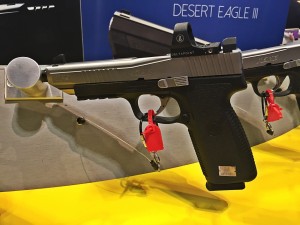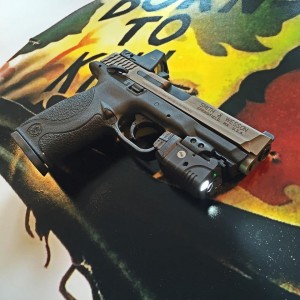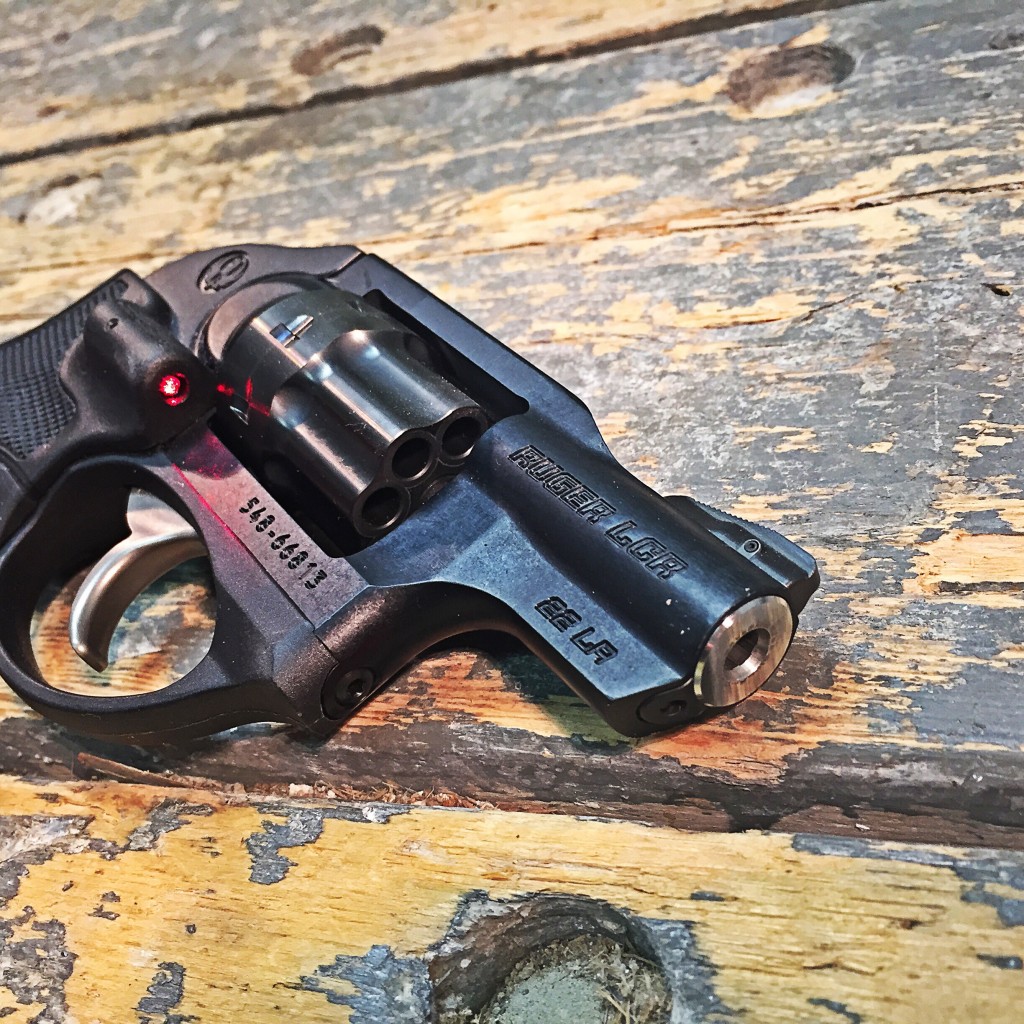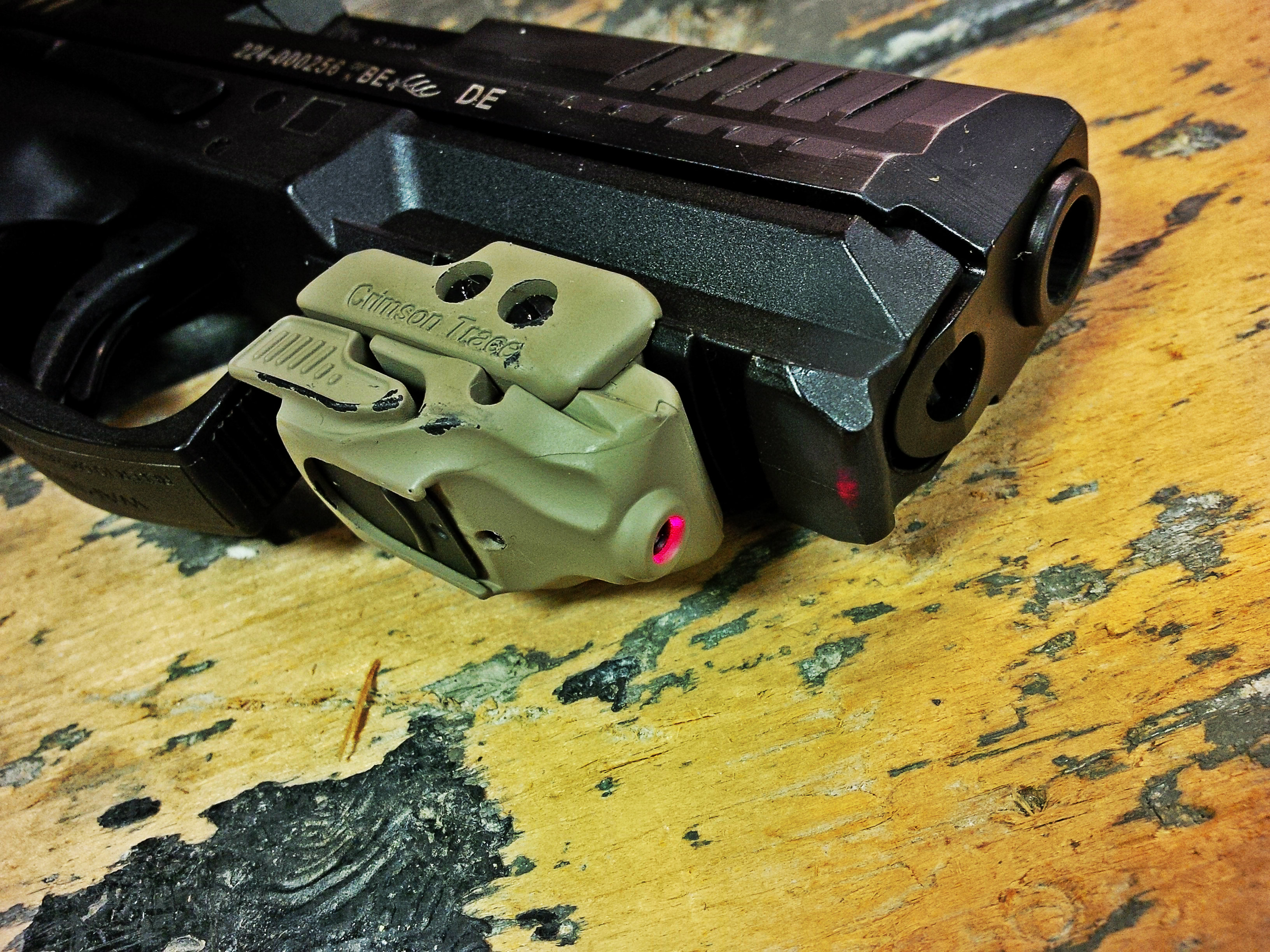Two topics we’ve spent a lot of time and energy on here at Gun Nuts: lasers on defensive pistols and red dot sights on defensive pistols. It’s no secret that I’m a big fan of both ideas for a lot of reasons, and that I recommend Crimson Trace lasers for any serious defensive pistol. But what if you only have the money for one electronic sighting system? Which should you choose, a dot or a beam?

First, let’s look at the pros and cons shared by both systems, and then some of the pros/cons that are unique to each.
Pros
1. Allow the shooter to keep his/her eyes on the threat
This is actually a big one. To me, the biggest advantage of red dots or lasers is the ability for me as the shooter to keep both eyes open and focused on the bad person who is intent on doing bad things to me. That means I can see their hands, see their movements, and just generally have a better idea of what they’re doing. This is especially useful from an LE point of view, where you may be required to hold someone at gunpoint for an extended period of time. It’s also still useful as an armed citizen.
2. Easier for new shooters to pick up
The interface is pretty simple. Assuming the dot/beam is properly sighted in, it’s “put dot where want bullet go, press trigger.” No worrying about sight alignment or anything like that, just point and click. Too easy.
3. Works at night
Night sights are important, that’s generally something we can all agree on. Dots and beams have the benefits of night sights, but again are easier to manage in most circumstances owing to their nature.
Cons
1. Batteries
Hey, no one likes to talk about this, but it is an issue. Despite the fact that most modern dots/beams have a battery life measured in years, this needs to come up. It needs to be brought up because if you’re the sort of person that forgets to change their oil and lets the smoke detector beep at you for two weeks, you’ll probably forget to change the batters in your fancy electronic sight. As a side note, Trijicon makes an RMR that doesn’t use batteries, which is cool.

2. Cost
Again, dealing with reality here. There are a lot of people who balk at the idea of putting a $200 laser on a $400 gun, or a $500 optic on a $500 gun. I get that. Money is a real issue, and after you’ve already followed my advice and spent $500 on a Glock 19, plus another $100 on a quality holster and belt, the thought of dropping basically all that again just to get some fancy electronic sight? Seems crazy.
3. Mounting and holsters
Here’s the last issue. Say you do want a dot, well now you have to mount it. That means either mounting in the rear sight dovetail, which isn’t a very durable long term option, or getting your slide milled by a machinist, which means another $200-400 out the door. Lasers have a similar problem, because if you’re unlucky enough to have a gun that Crimson Trace doesn’t make a laser grip for, you’re going to need a special holster just to fit your rail mounted light/laser combo. That can get expensive depending on your gun.
Red dot sights have a specific con of their own; the dot is slower to pick up for the first shot than traditional iron sights for experienced shooters. My personal experience shows that novices and less skilled shooters are quicker with the red dot; but that’s a training issue. Lasers have an issue as well, in that they could give away your position. Personally I think that’s a stupid objection to their use unless you’re planning on fighting ninjas in the dark, but if I don’t mention it someone will.
But the real question is which one is better? That’s complicated, because there are a lot of variables in that equation. I’ll try to eliminate some of those, and we’ll assume that this purchase is for a moderately experienced shooter. Let’s say IDPA Sharpshooter class, they’ve taken a scattering of classes here and there, they practice sometimes – basically 80% of my readers. For that shooter, I’d actually recommend the laser, and especially a Crimson Trace Laser Grip. Don’t get my wrong, I love red dot guns, I really do.

Ideally I’d say get both, but if you could only have one and you fit the shooter profile listed above, I think the laser is the better choice. The instinctive activation that Laser Grips offer coupled with all the advantages of keeping both eyes open and being able to focus on the threat make it a no-brainer anyway. When you add in the fact that you can track the dot in recoil and it makes shooting at moving targets comically easy (try it sometime) I can’t really think of a single good reason to not get the laser.
That being said, I have guns with lasers, guns with dots, and guns with neither. I really try to let whatever I need the gun for drive the train of how it’s going to get used. But for the shooters I’m talking about, I think the laser is the best choice.
Looking for the best deal on Lasers or Red Dots? Check out what Short Round Supply has to offer!

Maybe just me, but I pick up irons a lot faster than the laser sight and to me they’re just plain annoying. I think another con which you’ve sort of covered involves relying on either system over iron sights. What happens when the batteries die? Or something breaks? In the heat of a defensive gun use are you going to be comfortable with irons if you train mainly with optics or lasers?
Something I didn’t cover is the training piece – I recommend people get good using irons first before depending on any one of these systems. Although modern dots and beams are pretty rugged and well tested, I believe that being strong with iron sights first is the best way to go…just in case.
Honestly I’m not a fan of either *on my handgun*, reasons being:
1. I don’t like having a lot of crap hanging off my guns. It messes with the balance and frankly quickly adds weight and controls that can get bumped at impertinent times.
2. if I’ve got anything on my rail it’s a light, so I’m already breaking my Cardinal rule of guns.
For a shotgun or rifle, I’m good with a few extra bolted on parts (a sling, backup iron sights, a light and a red dot) make sense when your now talking about a bigger platform. Reasons being:
1. It’s better supported, look two hands On one handle is always going to be weaker than two hands on two ends of the weapon plus a shouldered stock.
2. A bigger gun with the extra real estate to put rails for mounting extra goodies. This may sound like I’m getting ready to do something dumb like mount a chainsaw or garage door opener but I’m not, it comes down to having enough space to put my hands on the gun without giving up grip or accidentally hitting controls.
Crimson Trace is great for about 90% of shooters, but for those of us who shoot southpaw, they just aren’t an option as the laser points directly at our thumbs instead of the target.
Lasers can be a beast to focus on under stress as well. When people are moving, shooting, and trying to avoid getting shot; attempting to find a little red dot amid violence is just absurd.
Personally, I use a light mounted under the barrel. I do this for multiple reasons.
1. Night Sights < Night Lights.
It doesn't matter how well I can see the sights, if I don't have a clear view of the threat, I'm probably not pulling the trigger. Liability issues rule the day here, and a light allows me to clearly see my target and what is behind it while a laser just gives me a rough estimate of point of impact.
2. Most lights will give just as good of a POI estimate as a laser. Find the center of the big glowing beam of light and the bullet will impact just about an inch above that point. And the center of the circle of light is much quicker to find than a little red dot when stuff has hit a fan.
3. A laser may intimidate someone, but 350 lumens will blind them. Doesn't matter if it's midnight or noon, get hit with a bright enough light and your vision goes to zero.
I’m glad you posted this, because I wanted to write on the topic of lights vs lasers if you can only have one.
Something I’ve noticed with combo light/laser units, that I just can’t figure out…
Why do they always put the laser furthest away from the boreline, when it should be as close as possible? Some of these units put the laser two inches below the muzzle. Would it really be that hard to tuck the laser up against the frame/rail and hang the light down off the bottom?
I’m curios about the differing origin points creating dual dots anywhere but where they are zeroed. Does this happen? If so, how distracting or difficult is it to use? Or is the deviation so little that it basically doesn’t matter?
I actually had dual dots set up on an M&P for a while. I found it to be crazy distracting, since even though both dots were zeroed for the same POI, they appeared visually in two different places. I got rid of one.
Interesting. I figured it would play into it. Oh, and since you brought up batteries, the backstraps of the Timberwolf frame actually have a recess for a 2032 battery.
Leupold seems to have come up with a great idea for helping shooters pick up the red dot faster. On the new Deltapoint Pro, one can add an optional rear sight. Supposedly, it helps acquire the dot faster, and it works as a standard site if the optic goes down.
I wanted to try this setup on my 629, but finding the new one in stock, at a reasonable price, and finding the add-on rear site was near impossible. So I went with the RMR.
Needs a Pro #4:
Allows older eyes to shoot accurately. Those over 42½ often have poor accommodation, and cannot effectively use iron sights (with or without tritium insets), unless they are wearing their special range prescription. Both optics and lasers fix that. You then only need vision focused at perp distance.
There’s also a Pro #5 that applies only to laser: intimidation
Pulling the trigger is the last resort. Anything that can resolve the incident short of that, with no other downside, is worth considering. If the scenario provides enough time for the perp to reconsider the plan, a laser is a lot more attention-getting than what might appear to be some sort of weird magnifying glass above the frame.
Re: … unlucky enough to have a gun that Crimson Trace doesn’t make a laser grip for …
Even if you do have an LG-compatible, it’s still not uncommon to need to cut away part of the holster.
I have used red dots for years and for shot guns in particular, they are the stuff. Easy to use and on hand guns and rifles can be used to great effect at surprising distances. The problem I have with lasers is the reverse of height over bore, with the laser sighted in as most suggest, with the dot on the top of the front sight, the set only works at one distance, at any other it is either high or low. If I just sight it so that it is parallel to the bore, I don’t need the sights. It has been an interesting exercise so far. I have a Streamlight TL4 on a Walther PK380.
I don’t have much experience with red dots on a pistol, but what I did notice was that it really messed with getting a decent ‘flash sight picture’. For that reason, I decided against one on a defensive pistol.
Since I have had cataract surgery , I have a hard time focusing on the front sight. I really liked the Bomar type of sights, and in the past could use them well out to 100 yards, now I have to try new things and re-learn how to shoot.
Lemme see…
Laser/light combo: As long as you’re not picky about being able to holster said combo, then you can get away with a good one at about $150.
Mini red-dot: It doesn’t matter if you’re picky, by the time you’re done getting mounting options for it and selecting a RD, you’ve had to take out a second mortgage.
The decision isn’t that hard.